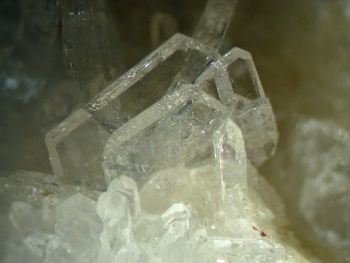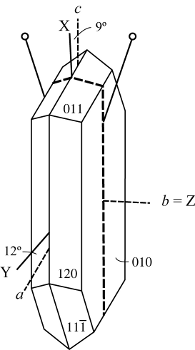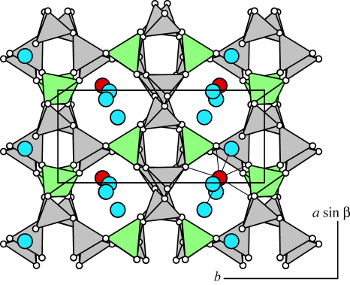
Fracture: conchoidal.
Hardness: 4.5 - 5. D = 2.20 to 2.23 gm/cm3.
Luster: vitreous to pearly, iridescent on {010}.
Streak: white.
Biaxial (- or +). α = 1.492 – 1.496, β = 1.497 – 1.499, γ = 1.502 - 1.504, δ = 0.005 - 0.006, 2Vx = 48° - 89°. X ˄ c = 6°-9°, Z = b. Dispersion: r < v, weak to distinct.

a 9.700, b 13.972, c 10.039 Å, β 111.07°.
Z = 1, Space group Pc.
(Kvick et al. 1986).

Thermal metamorphism of sediment and sedimentary rocks
One of the few instances, in which yugawaralite replaces volcanic sediment from arc-source terrains, is in the contact metamorphic aureole of the Tanzawa Mountains, central Japan (Seki et al. 1969). Yugawaralite occurs in the higher temperature half of Zone II, in which laumontite and other zeolites replace the fine-grained groundmass of basaltic and andesitic rocks. Besides laumontite, yugawaralite is associated with analcime, wairakite, calcite, and quartz. It is also a component in vein and cavity fillings in the same zone.
More commonly yugawaralite occurs in cavities or veins cutting lavas associated with sedimentary sections that have been weakly metamorphosed. For example, yugawaralite, associated with laumontite and calcite, occurs in cavities of basaltic lavas and pillow breccia at Nukabira, Hokkaido, Japan (Konno and Aoki 1977). The lavas along sediments of the Neogene Horoka Formation have been intruded by andesite causing a very low-grade of metamorphism.
Diagenesis of basalt and other kinds of lava flows
There are a few noted occurrences of yugawaralite in basalt cavities that may have originated from diagenetic alteration of basalt in regions of high heat flow. Yugawaralite occurs in cavities of Tertiary basalt at Skalafellshnuta, Skaftafekkssyska near Heinabergsjokell, southeastern Iceland (Barrer and Marshall 1965 and Tschernich 1992, p. 524). Large crystals of yugawaralite occur with okenite, hydroxyapophyllite, prehnite, and laumontite in basalt cavities in the Khandivali quarry north of Bombay, India (Wise 1978). Pongiluppi (1977) describes yugawaralite in cavities of altered trachyandesite exposed on the slope of Mt. Crastu Muradu near Osilo, Sassari, Sardinia, Italy. It occurs with laumontite, heulandite, and stilbite on a substrate of calcite. Large crystals of yugawaralite occur in veins cutting altered andesite at Shimoda (Sameshima 1969), and with wairakite at Toi-cho, both in Shizuoka Prefecture, Japan. Yugawaralite has been found with heulandite in vesicles of a shallow, Lower Permian doleritic intrusives in the northern Takitimu Mountains, Southland, New Zealand (Houghton 1982).
Hydrothermal systems.
There are several occurrences of yugawaralite in active hydrothermal systems. Yugawaralite was first described from Hudo-no-taki Falls near Yugawara Hot Spring, Kanagawa Prefecture, Japan. It occurs with laumontite and quartz in veins 2 to 5 cm wide cutting altered andesitic tuff-breccia (Harada et al. 1969). Seki and Okumura (1968) described yugawaralite in a hydrothermally altered dacitic tuff recovered from drill core at the Onikobe geothermal area, northeast Japan. The core can be divided into three zones depending on a key zeolite, mordenite, laumontite, and wairakite. Although there is some overlap of the laumontite and wairakite zones, the yugawaralite occurs only with laumontite. The occurrence is at a depth of 138.7 m and at a temperature of 110°C.
Bargar and Beeson (1981) and Bargar et al. (1981) describe yugawaralite in core from two drill holes, Y-2 and Y‑3 in the Lower Geyser Basin, Yellowstone National Park, Wyoming. Despite the fact that the wall rocks are rhyolitic tuff, several calcic-zeolites occur in these cores. In drill hole Y-2 yugawaralite occurs in a narrow zone at a temperature of about 200°C, and in hole Y-3 it occurs where the temperature is about 270°C.
The presence of yugawaralite and wairakite in the Abanico Hill area indicate an abrupt change in the burial metamorphic effects in an Upper Cretaceous and Tertiary sequence of central Chile (Vergara et al. 1993). Zoning toward a graben indicated by yugawaralite±laumonite and then wairakite±epidote is evidence for a fossil “geothermal-type” alteration overprint on the regional zeolitic burial metamorphism.
The occurrence of yugawaralite along the Chena River east of Fairbanks, Alaska, is in veins cutting a siliceous xenolith (20m by 50m) in a small porphyritic quartz monzonite pluton (Eberlein et al. 1971). The host rock is a brecciated metachert, and fractures are filled or partially filled with yugawaralite associated with quartz, laumontite, stellerite, and stilbite. The occurrence of yugawaralite and laumontite suggest hydrothermal fluids may have precipitated the zeolites.
Crystals of yugawaralite occur with heulandite, stilbite, and laumontite in veins of hydrothermally altered basalt at Hvalfjordur, Borgafjardarsysla north of Reykjavik, Western Iceland (Tschernich 1992).
Yugawaralite occurs with laumontite, wairakite, calcite, and quartz in Jurassic basaltic rocks of the Letba Formationb (Karoo sequence) along the Mukuze Rover, northwest of Mkuze, northeastern KwaZulu-Natal, South Africa (Weinert et al. 2000). It is suggested that this assemblage formed by the thermal metamorphism associated with a local dolerite dike.Alberti, A., Quartieri, S., and Vezzalini, G. 1994. Structural modifications induced by dehydration in yugawaralite. In Zeolites and Related Microporous Materials. State of the Art 1994. Weitkamp, J., Karge, H.G., Pfeifer, H., and Höldrich, W. (eds) Studies in Surface Science and Catalysis 84, 637-644
Bargar, K.E. and Beeson, M.H. 1981. Hydrothermal alteration in research drill hole Y-2. Lower Geyser Basin, Yellowstone National Park, Wyoming. Am. Mineral. 66, 473-490.
Bargar, K.E., Beeson, M.H. and Keith, T.E.C. 1981. Zeolites in Yellowstone National Park. Min. Rec. 12, 29-38
Barrer, R.M. and Marshall, D.J. 1965. Synthetic zeolites related to ferrierite and yugawaralite. Am. Mineral. 50, 484-489.
Eberlein, G.D., Erd, R.C., Weber, F. and Beatty, L.B. 1971. New occurrence of yugawaralite from the Chena Hot Springs area, Alaska. Am. Mineral. 56, 1699-1717.
Gottardi, G. and Galli, E. 1985. Natural Zeolites, Springer-Verlag, Berlin, Germany. 409 pp.
Harada, K., Nagashima, K. and Sakurai, K. 1969. Chemical composition and optical properties of yugawaralite from the type area. Am. Mineral. 54, 306-309.
Houghton, B.F. 1982. Low-grade metamorphism of the Takitimu Group, western Southland, New Zealand. New Zeal. J. Geol. Geophys. 25, 1-19.
Kerr, I.S. and Williams, D.J. 1967. The crystal structure of yugawaralite. Z. Kristallogr. 125, 220-225.
Kerr, I.S. and Williams, D.J. 1969. The crystal structure of yugawaralite. Acta Crystallogr. 25, 1183-1190.
Konno, H. and Aoki, M. 1977. Yugawaralite from Nukabira, Hokkaido. Mineral. Jour. 8, 456-462.
Kvick, Å., Artioli, G. and Smith, J.V. 1986. Neutron diffraction study of the zeolite yugawaralite at 13 K. Z. Kristallogr. 174, 265-281.
Leimer, H.W. and Slaughter, M. 1969. The determination and refinement of the crystal structure of yugawaralite. Z. Kristallogr. 130, 88-111.
Pongiluppi, D. 1977. A new occurrence of yugawaralite at Osilo, Sardinia. Can. Mineral. 15, 113-114.
Sakurai, K. and Hayashi, A. 1952. “Yugawaralite”, a new zeolite. Sci. Rep., Yokohama Nat. Univ., Ser II, 1, 69-77.
Sameshima, T. 1969. Yugawarlite from Shimoda, Shizuoka Prefecture, central Japan. Geoscience Journal (Journal of the Japanese Association of Amateur Mineralogists) 20, 71-78 (Mineralogical Abs. 29-77).
Seki, Y., Oki, Y., Matsuda, T., Mikami, K. and Okumura, K. 1969. Metamorphism in the Tanzawa Mountains, Central Japan. J. Japan. Assoc. Miner Petrol. Econ. Geol., 61, 1-75.
Seki, Y. and Okumura, K. 1968. Yugawaralite from Onikobe active geothermal area, northeast Japan. Jour. Japan. Assoc. Min. Petr. Econ. Geol., 60, 27-33.
Tanaka, T., Kimura, R., Akizuki, M. and Kudoh, Y. 2002. Origin of low-symmetry growth sectors in edingtonite and yugawarlite, and the crystal structure of the k{011} and v{120} sectors of yugawaralite. Min. Mag. 66, 409-420.
Tschernich, R.W. 1992. Zeolites of the World. Geoscience Press, Tucson, Arizona. 563 pp.
Vergara, M., Levi, B. and Villarroel, R. 1993. Geothermal-type alteration in a burial metamorphosed volcanic pile, central Chile. J. Metam. Geol. 11, 449-454.
Weinert, C.H., Weinert, S.W. and Dunlevey, J.N. 2000. Yugawaralite in the Letaba formation, northeastern KwaZulu-Natal, South Africa. South African J. Geol. 103, 69-73.
Wise, W.S. 1978. Yugawaralite from Bombay, India. Min. Rec. 9, 296.